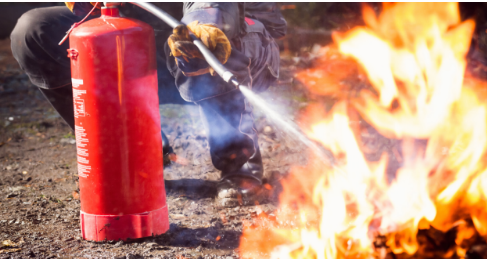Imagine it’s 2 a.m. You’re finally deep in sleep when a rogue thought snaps you awake: “Did I lock the front door?”
For most people, it’s a fleeting panic. But for business owners running construction sites, commercial buildings, or warehouses, it’s more like: “Did I prepare for a fire hazard?”
Not exactly a comforting thought.
That’s where a Fire Watch Plan comes in—your around-the-clock safety sidekick. Think of it as the Batman of emergency preparedness, watching over your property when things could go wrong.
If you’re wondering how to build one, this guide walks you through it—step by step—with practical advice, a touch of humor, and an expert tip that could save you time (and stress).
Step 1: Identify Fire Hazards
Before any planning happens, you need to know your fire risks.
It’s like planning a party—you first figure out who’s most likely to break the furniture (Kevin with the tequila) before making a strategy.
Walk through your site and pinpoint:
- Flammable materials or chemicals in storage.
- Overheating machinery or faulty wiring.
- Designated smoking areas (or unofficial ones… looking at you, Carl).
Pro Tip: Check those obscure corners and unused equipment—fire hazards love to hide in places people forget.
Step 2: Build Your Fire Watch Team
This crew is your safety Avengers.
Whether it’s trained in-house staff or a professional service (more on that later), your team needs to:
- Conduct consistent patrols.
- Keep a detailed log (if it’s not documented, it didn’t happen).
- Ensure emergency exits and fire extinguishers are accessible and functional.
Reality Check: Don’t assign this to just anyone. Fire watch duties require awareness, training, and commitment—not someone who zones out halfway through.
Step 3: Draft a Simple, Actionable Plan
Forget a 30-page manual filled with technical jargon. Your Fire Watch Plan should be easy to read, quick to follow, and available at a glance.
Include:
- Roles & responsibilities:Who does what?
- Patrol schedule:How often and when.
- Communication procedures:Who do they report issues to?
- Emergency response steps:Clear evacuation routes and alarm activation instructions.
Place this plan somewhere visible—next to the coffee machine works better than buried in a drawer.
Step 4: Train Your Team Properly
Would you expect someone to assemble IKEA furniture blindfolded? No? Then don’t expect your team to handle fire watch without training.
Effective training should cover:
- Fire prevention basics.
- Equipment handling and maintenance.
- Evacuation and emergency response drills.
Pro Move: Bring in professionals like The Fast Fire Watch Company. They offer trained personnel who know the job inside out—and they don’t wing it when it counts.
Step 5: Use Smart Technology
Fire safety isn’t stuck in the past. Leveraging the right tech can make your Fire Watch Plan stronger and more efficient.
Consider:
- Surveillance camerasto monitor high-risk areas.
- Functioning alarm systems(test them regularly!).
- Mobile logging appsto track patrols and communication in real time.
Technology doesn’t replace humans, but it makes them even better at their job—like having a sidekick that never sleeps.
Step 6: Schedule Consistent Inspections
A Fire Watch Plan isn’t a one-and-done deal. Regular inspections are a must to ensure everything stays fire-ready.
Check:
- Fire alarms and extinguishers.
- Electrical wiring and outlets.
- Emergency exits (no, propping open fire doors is neverokay).
Pro Tip: Document everything. Not just for compliance, but for accountability and continuous improvement.
Step 7: Bring in the Experts
Sometimes, it pays to leave things to the pros.
The Fast Fire Watch Company offers:
- Certified guards trained to detect and neutralize risks.
- 24/7 service—because fires don’t check the clock.
- Tailored solutions that keep you compliant and within budget.
This isn’t just a pitch—it’s practical advice. Managing fire watch responsibilities alone can be overwhelming. Having expert support? That’s a game-changer.
Step 8: Communicate the Plan Clearly
The best plan in the world is useless if no one knows it exists.
Make sure your Fire Watch Plan is communicated across your team using:
- Quick team meetings.
- Signage or visual reminders.
- Digital updates through your internal communication platform.
When an emergency hits, no one should be asking, “Wait, what are we supposed to do again?”
Final Thoughts: Safety Without the Stress
Implementing a Fire Watch Plan doesn’t have to be overwhelming. While it may seem like a lot at first—identifying risks, organizing a team, drafting procedures, and staying compliant—it’s ultimately about protecting your people, property, and peace of mind. The key is to focus on consistency, clear communication, and regular follow-through. You don’t need to reinvent the wheel, but you do need a system that works when it matters most.
And here’s the thing: you don’t have to do it all alone. Bringing in trusted professionals like The Fast Fire Watch Company can make the entire process smoother, more efficient, and far less stressful. Their trained guards, 24/7 availability, and customized solutions allow you to meet safety standards while freeing up your time and energy for everything else your business demands.
In short, a reliable Fire Watch Plan isn’t just a checklist—it’s your silent shield. And with the right support, it’s one you’ll never lose sleep over.


